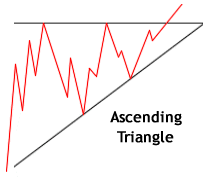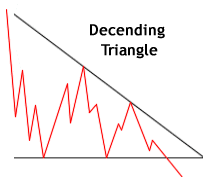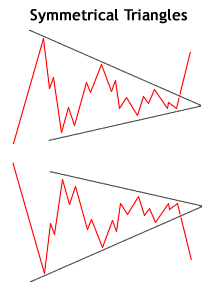In the study of technical analysis, triangles fall under the category of continuation patterns. There are three different types of triangles, and each should be closely studied. These formations are, in no particular order, the ascending triangle, the descending triangle and the symmetrical triangle.
Triangles can be best described as horizontal trading patterns. At the start of its formation, the triangle is at its widest point. As the market continues to trade in a sideways pattern, the range of trading narrows, and the point of the triangle is formed. In its simplest form, the triangle shows losing interest in an issue, both from the buy side as well as the sell side: the supply line diminishes to meet the demand.
Think of the lower line of the triangle, or lower trendline, as the demand line, which represents support on the chart. At this point, the buyers of the issue outpace the sellers, and the stock's price begins to rise. The supply line is the top line of the triangle and represents the overbought side of the market, when investors are going out taking profits with them.
Triangles can be best described as horizontal trading patterns. At the start of its formation, the triangle is at its widest point. As the market continues to trade in a sideways pattern, the range of trading narrows, and the point of the triangle is formed. In its simplest form, the triangle shows losing interest in an issue, both from the buy side as well as the sell side: the supply line diminishes to meet the demand.
Think of the lower line of the triangle, or lower trendline, as the demand line, which represents support on the chart. At this point, the buyers of the issue outpace the sellers, and the stock's price begins to rise. The supply line is the top line of the triangle and represents the overbought side of the market, when investors are going out taking profits with them.
Ascending Triangle Pattern
Often a bullish chart pattern, the ascending triangle pattern in an uptrend is not only easy to recognize but is also a slam-dunk as an entry or exit signal. It should be noted that a recognized trend should be in place for the triangle to be considered a continuation pattern. In figure 1, you can see an uptrend is in place and the demand line, or lower trendline is drawn to touch the base of the rising lows. The two highs have formed at the top line. These highs do not have to reach the same price point but should be close to each other.
The buyers may not be able to break through the supply line at first and they may take a few runs at it before establishing new ground and new highs. The chartist will look for an increase in the trading volume as the key indication that new highs will form. An ascending triangle pattern will take about four weeks or so to form and will not likely last more than 90 days.
How do the longs (the buyers) know when to jump into the issue? Most analysts will take a position once the price action breaks through the top line of the triangle with increased volume, which is when the stock price should rise an amount equivalent to the widest section of the triangle.
Descending Triangle Pattern
The descending triangle is recognized primarily in downtrends and is often thought of as a bearish signal. As you can see in figure 2, the descending triangle pattern is the upside-down image of the ascending triangle pattern. The two lows on the above chart form the lower flat line of the triangle and, again, have to be only close in price action rather than exactly the same. The development of the descending triangle takes the same amount of time as the ascending triangle, and volume again plays an important role in the breakout to the downside. (Some analysts believe that increased volume is not all that important. We, however, believe it to be paramount. We always consider the strength or weakness of volume as being the "straw that stirs the drink.")
 |
| Figure 1 |
Often a bullish chart pattern, the ascending triangle pattern in an uptrend is not only easy to recognize but is also a slam-dunk as an entry or exit signal. It should be noted that a recognized trend should be in place for the triangle to be considered a continuation pattern. In figure 1, you can see an uptrend is in place and the demand line, or lower trendline is drawn to touch the base of the rising lows. The two highs have formed at the top line. These highs do not have to reach the same price point but should be close to each other.
The buyers may not be able to break through the supply line at first and they may take a few runs at it before establishing new ground and new highs. The chartist will look for an increase in the trading volume as the key indication that new highs will form. An ascending triangle pattern will take about four weeks or so to form and will not likely last more than 90 days.
How do the longs (the buyers) know when to jump into the issue? Most analysts will take a position once the price action breaks through the top line of the triangle with increased volume, which is when the stock price should rise an amount equivalent to the widest section of the triangle.
Descending Triangle Pattern
 |
| Figure 2 |
The descending triangle is recognized primarily in downtrends and is often thought of as a bearish signal. As you can see in figure 2, the descending triangle pattern is the upside-down image of the ascending triangle pattern. The two lows on the above chart form the lower flat line of the triangle and, again, have to be only close in price action rather than exactly the same. The development of the descending triangle takes the same amount of time as the ascending triangle, and volume again plays an important role in the breakout to the downside. (Some analysts believe that increased volume is not all that important. We, however, believe it to be paramount. We always consider the strength or weakness of volume as being the "straw that stirs the drink.")
Symmetrical Patterns
So far we have seen two triangle patterns: one, from an uptrend and bullish market move and one from a downtrend with a decidedly bearish look. Symmetrical triangles, on the other hand, are thought of as continuation patterns developed in markets that are, for the most part, aimless in direction. The market seems listless in its direction. The supply and demand therefore seem to be one and the same.
During this period of indecision, the highs and the lows seem to come together in the point of the triangle with virtually no significant volume. Investors just don't know what position to take. However, when the investors do figure out which way to take the issue, it heads north or south with big volume in comparison to that of the indecisive days and/or weeks leading up to the breakout. Nine times out of 10, the breakout will occur in the direction of the existing trend. But, if you are looking for an entry point following a symmetrical triangle, jump into the fray at the breakout point.
The Bottom Line
These patterns, both the symmetrical triangles on the bullish as well as the bearish side are known to experience early breakouts that give investors a "head fake." Hold off for a day or two after the breakout and determine whether or not the breakout is for real. Experts tend to look for a one-day closing price above the trendline in a bullish pattern and below the trendline in bearish chart pattern. Remember, look for volume at the breakout and confirm your entry signal with a closing price outside the trendline.
So far we have seen two triangle patterns: one, from an uptrend and bullish market move and one from a downtrend with a decidedly bearish look. Symmetrical triangles, on the other hand, are thought of as continuation patterns developed in markets that are, for the most part, aimless in direction. The market seems listless in its direction. The supply and demand therefore seem to be one and the same.
During this period of indecision, the highs and the lows seem to come together in the point of the triangle with virtually no significant volume. Investors just don't know what position to take. However, when the investors do figure out which way to take the issue, it heads north or south with big volume in comparison to that of the indecisive days and/or weeks leading up to the breakout. Nine times out of 10, the breakout will occur in the direction of the existing trend. But, if you are looking for an entry point following a symmetrical triangle, jump into the fray at the breakout point.
 |
| Figure 3 |
The Bottom Line
These patterns, both the symmetrical triangles on the bullish as well as the bearish side are known to experience early breakouts that give investors a "head fake." Hold off for a day or two after the breakout and determine whether or not the breakout is for real. Experts tend to look for a one-day closing price above the trendline in a bullish pattern and below the trendline in bearish chart pattern. Remember, look for volume at the breakout and confirm your entry signal with a closing price outside the trendline.